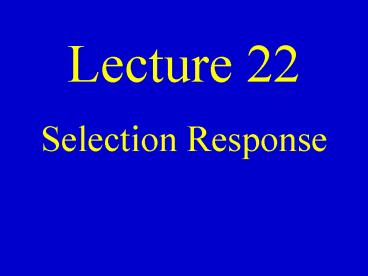Selection Response - PowerPoint PPT Presentation
1 / 56
Title:
Selection Response
Description:
rBV,EBV = aij bBVi on Pj = (4 - .36)/ .36 = 11.1. Comparing Selection Programs ... For PHS bBVi on Pj = 2q and aij= 1/2. q .78 = 1/2 2q = q. q q q = 17.2 ... – PowerPoint PPT presentation
Number of Views:72
Avg rating:3.0/5.0
Title: Selection Response
1
Lecture 22
Selection Response
2
Distribution of EBVs
3
Distribution of EBVs
females
4
Distribution of EBVs
males
females
5
Selection Response
6
Selection Response
?Gm response to selection of males per
generation (?Gf for females)
7
Selection Response
?Gm response to selection of males per
generation (?Gf for females) response
change in the average genetic merit
8
Selection Response
?Gm response to selection of males per
generation (?Gf for females) response
change in the average genetic merit ?Gm
intensity of selection (im) X accuracy of
evaluation (rmBV,EBV) X standard deviation
of BVs (?BV)
9
Selection Response
?Gm im rmBV,EBV ?BV
10
Selection Response
?Gm im rmBV,EBV ?BV ?Gf if rfBV,EBV
?BV
11
Selection Response
?Gm im rmBV,EBV ?BV ?Gf if rfBV,EBV
?BV ?G ?Gm ?Gf 2 total response
per generation
12
Selection Response
?g response to selection per year
13
Selection Response
?g response to selection per year ?Gm
?Gf Lm Lf
14
Selection Response
?g response to selection per year ?Gm
?Gf Lm Lf L generation interval
average age of the parents for progeny born
in a year
15
3 of 4 Components can be Manipulated
16
3 of 4 Components can be Manipulated --
intensity -- accuracy -- generation interval
17
3 of 4 Components can be Manipulated --
intensity -- accuracy -- generation interval
sometimes conflicting
18
Male Selection
19
Male Selection
Example litter size progeny test Need two
males
20
Male Selection
Housing for 50 females 10 males with 5
daughters 50 5 males with 10 daughters 50
21
Male Selection
Housing for 50 females 10 males with 5
daughters 50 5 males with 10 daughters
50 2/10 versus 2/5 males-- different intensity 5
versus 10 progeny -- different accuracies
22
Male Selection
--to achieve greater intensity sacrifice accuracy
23
Female Selection
24
Female Selection
Example 1st record -- 3 years of age 2nd
record -- 4 years of age
25
Female Selection
Example 1st record -- 3 years of age 2nd
record -- 4 years of age Second record provides
more information hence increases accuracy, but
need a year more to get it. -- accuracy versus
generation interval--
26
Intensity
P
27
Intensity
P
28
Intensity
a) selection differential (Ps - P)
29
Intensity
a) selection differential (Ps - P) --average
phenotypic superiority
30
Intensity
a) selection differential (Ps - P) --average
phenotypic superiority b) selection intensity
(i)
31
Intensity
a) selection differential (Ps - P) --average
phenotypic superiority b) selection intensity
(i) i Ps - P ?P
32
Intensity
a) selection differential (Ps - P) --average
phenotypic superiority b) selection intensity
(i) i Ps - P ?P -- standardize
superiority expressed in standard deviations
33
Intensity
If the population is large , i is directly
related to the fraction saved.
34
Intensity
If the population is large , i is directly
related to the fraction saved. saved i
(S.D.s) 90 .195
35
Intensity
If the population is large , i is directly
related to the fraction saved. saved i
(S.D.s) 90 .195 50 .795
36
Intensity
If the population is large , i is directly
related to the fraction saved. saved i
(S.D.s) 90 .195 50 .795 10 1.755
37
Intensity
If the population is large , i is directly
related to the fraction saved. saved i
(S.D.s) 90 .195 50 .795 10 1.755 1
2.660
38
Comparing Selection Programs
39
Comparing Selection Programs
Program 1
40
Comparing Selection Programs
Program 1 A) Select males on their
performance. (h2 .36 for yearling weight)
?Gm (1.755)(.6) ?BV 1.053 ?BV
41
Comparing Selection Programs
Program 1 B) Select females on their
performance rBV,EBV .6 Keep 80 gt if
.35
?Gf (.35)(.6) ?BV .210 ?BV
42
Comparing Selection Programs
Program 1 C) Assume Lm Lf 4 ?Gm
(1.755)(.6) ?BV 1.053 ?BV ?Gf (.35)(.6)
?BV .210 ?BV and ?g 1.053?BV
.210?BV .158?BV 4 4
43
Comparing Selection Programs ?BV 40
Program 1 C) Assume Lm Lf 4 If ?BV 40
lbs (.158)(40) 6.32 lbs per year
44
Comparing Selection Programs
Program 2
45
Comparing Selection Programs
Program 2 A) Select females the same. if
.35 rBV,EBV .6 Lf 4
46
Comparing Selection Programs
Program 2 B) Progeny test males Still keep
10 gt im 1.755 Lm 6 instead of 4
47
Comparing Selection Programs ?BV 40
To compare, first solve for the rBV,EBV for males
necessary to be equal. ?g 6.32 lbs
(1.755)rBV,EBV(40) .21(40) 6 4
48
Comparing Selection Programs ?BV 40
To compare, first solve for the rBV,EBV for males
necessary to be equal. ?g 6.32 lbs
(1.755)rBV,EBV(40) .21(40) 6
4 Must solve for rBV,EBV
49
Comparing Selection Programs
(6.32)(10) (1.755)rBV,EBV(40) .21(40)
50
Comparing Selection Programs
(6.32)(10) (1.755)rBV,EBV(40)
.21(40) (1.755)rBV,EBV 1.37
51
Comparing Selection Programs
(6.32)(10) (1.755)rBV,EBV(40)
.21(40) (1.755)rBV,EBV 1.37 rBV,EBV .78
52
Comparing Selection Programs
(6.32)(10) (1.755)rBV,EBV(40)
.21(40) (1.755)rBV,EBV 1.37 rBV,EBV .78 How
many progeny to reach .78?
53
Comparing Selection Programs
rBV,EBV aij bBVi on Pj ? (4 - .36)/ .36
11.1
54
Comparing Selection Programs
rBV,EBV aij bBVi on Pj ? (4 - .36)/ .36
11.1 For PHS bBVi on Pj 2q and aij 1/2 q
?
55
Comparing Selection Programs
rBV,EBV aij bBVi on Pj ? (4 - .36)/ .36
11.1 For PHS bBVi on Pj 2q and aij 1/2 q
? .78 1/2 2q q q ? q
? q 17.2 gt 18 progeny
56
Comparing Selection Programs
-- Program 2 is better if we can get gt 18
progeny / bull. --































